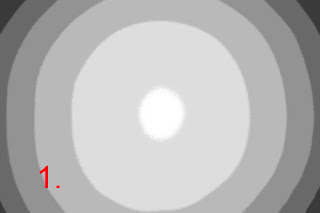
To wrap things up on this series of posts, here are some personal observations on images created with point-and-shoot consumer pocket cameras like the Canon G9. This photo is a ground-level view of the Lackawanna Train Station, now a historical museum, in Vestal, NY. It was shot with G9 and processed using the techniques we've been going through. Shot at 7.4 mm and f/4, the processing removed the mustache distortion (combination barrel and pincushion distortions often seen in shorter focal length zooms), we've reduced the transverse chromatic aberration, and we compensated for the light fall-off (vignetting) at the edges.

Looking at a detail of the original image, we can see the chromatic aberration along the high-contrast edges of an eave ornament. After processing we see the chromatic aberration cleaned up and image details are sharper.

So let's summarize what we're working with:
- Small-sensor pocket cameras have great depth of field. In many cases this is good but it substantially removes one of the creative controls you have with a DSLR and fast lens: no chance of getting nice gauzy out-of-focus backgrounds with these cameras.
- Pocket cameras all have some amount of transverse and longitudinal chromatic aberration. We can reduce longitudinal (axial) chromatic aberration by using a smaller aperture; we can reduce transverse chromatic aberration using red and blue channel corrections. There are other chromatic aberrations inherent in the small sensors and inexpensive lenses that are beyond our ability to correct but these tend to be secondary.
- These small cameras (and many lenses on the big boys) have issues with geometric distortion. Barrel distortion, pincushion distortion, and even the more complex compound distortions can be corrected effectively. Not all pictures need this attention but ocean horizons, building edges, and other straight-line picture elements leap out when geometric distortion goes uncorrected.
- Small sensors have noise issues (at least as of this writing). Sadly the manufacturers still feel obligated to push the sensor resolution to ever-higher levels for marketing advantage but the price is paid in increased noise. Many cameras, like the Canon G9, would have far better images if the sensor sites were a bit larger even if it means a lower megapixel count.
- Looking up close at images created by any of these cameras will be clear to the experienced eye that they come from a smaller inexpensive point-and-shoot, and not one of the bigger pricier DSLRs or medium format digital cameras with good lenses.
- Almost any current point-and-shoot pocket camera is far more than adequate for images destined for the Web or for small family album prints. Only with extra care, as we've been exploring, will the images survive closer scrutiny and larger printing. However, you will not see an image taken with one of these class of cameras on the cover of Architectural Digest.
So, although it's tempting to say we can, with the tools and techniques described here, enhance a point-and-shoot image up into DSLR level of quality, that's only true if the shooter using a DSLR doesn't apply equal skill and similar tools to nudge those images to the next level of quality. The point-and-shoot images start off at a substantial disadvantage, can be improved greatly, but won't ever quite reach the quality of a carefully crafted DSLR image.
For the G9 in particular, here's a summary of its characteristics:
- Images suffer from moderate geometric distortions, edge fall-off, and chromatic aberrations as expected. None are show-stoppers and a carefully shot image can be cleaned up substantially using the techniques we've explored here.
- The aperture "sweet spot" for the G9 is between f/4 and f/5.6. Any lower and axial chromatic aberration becomes an issue. Any higher and diffraction starts turning detail to mush.
- Many of us who own the G9 wish the zoom range went a little lower, say to 24 mm equivalent rather than 35 mm. There is an after market for adapters to extend the zoom range optically. I've mentioned the Raynox wide-angle adapter which, when added to the G9, will yield a focal length down at the 24 mm equivalent range. The image, however, suffers greatly with uncorrectable vignetting at the corners at short focal lengths, bad geometric distortion and substantial chromatic aberration. Some, but not all, of this is correctable. My advice to anyone wanting quality 24 mm equivalent images from their G9 is don't consider the Raynox adapter. Maybe others are better but I have my doubts.
Bottom line: don't bring a knife to a gunfight. A consumer pocket camera does not compete with any reasonably good DSLR with a good lens. The pocket camera does, however, work great when you're not carrying a DSLR. The pocket cameras have some other strengths compared to DSLRs which we'll visit in future posts, not the least of which it attracts less attention than the flamboyant DSLRs. (For some reason some uninformed power-tripping Barney Fifes of law enforcement don't find pocket cameras the grave threat to national security that a SLR is, especially one mounted on a tripod.)




No comments:
Post a Comment